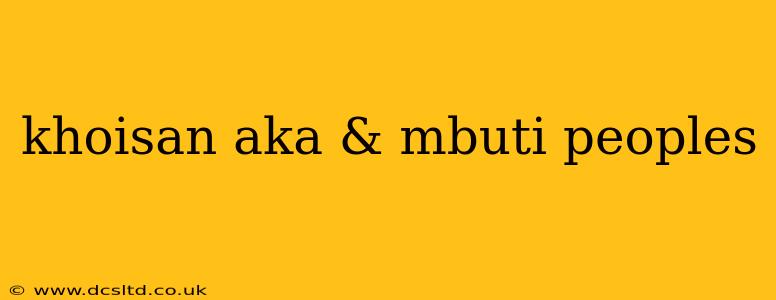The Khoisan and Mbuti peoples represent two distinct groups indigenous to Africa, each possessing unique cultural, linguistic, and genetic traits that have captivated researchers and anthropologists for decades. While geographically separated, both groups share a history often intertwined with misunderstanding and marginalization. This article delves into their distinct characteristics, histories, and current challenges, addressing common questions surrounding these fascinating populations.
What are the Khoisan people?
The Khoisan are a diverse group of indigenous peoples primarily inhabiting southern Africa. The term "Khoisan" is a linguistic classification encompassing two distinct branches: the Khoekhoe and the San. The Khoekhoe, also known as Nama or Namaqua, are largely pastoralists, while the San, often referred to as Bushmen, are known for their hunter-gatherer lifestyle. Genetic evidence suggests the Khoisan are among the oldest populations in Africa, with their ancestry tracing back tens of thousands of years. Their unique physical characteristics, including a pronounced epicanthic fold in some groups and a characteristic "click" consonant sound in their languages, set them apart. Their rich oral traditions and sophisticated knowledge of their environments are crucial aspects of their cultural heritage.
What are the Mbuti people?
The Mbuti, also known as the Efe or Bambuti, are a Pygmy group inhabiting the Ituri rainforest in the Democratic Republic of Congo. Unlike the Khoisan, the Mbuti are primarily forest-dwelling hunter-gatherers with a deep connection to their environment. Their egalitarian social structure, characterized by a lack of formal leadership and a strong emphasis on cooperation, is a defining feature of their culture. Their musical traditions, particularly their use of polyphonic singing, are renowned for their complexity and beauty. Their intimate knowledge of the rainforest and sustainable resource management practices provide valuable insights into human adaptation and environmental stewardship.
What language do the Khoisan speak?
Khoisan languages are characterized by the use of click consonants, sounds produced by sucking air into the mouth. These clicks are not found in most other languages globally, making them linguistically unique. There's significant diversity within Khoisan languages, with numerous distinct dialects and languages spoken across the region. The exact number is debated, as many are endangered or have already disappeared. The linguistic diversity reflects the rich cultural history and geographical spread of the Khoisan peoples.
What language do the Mbuti speak?
The Mbuti primarily speak various dialects of the Bantu languages, often incorporating their own unique vocabulary and grammatical structures. Their languages reflect their close ties to neighboring Bantu-speaking communities, although their distinct cultural identity remains strong. While their languages share similarities with broader Bantu language families, the Mbuti dialects often have unique features that reflect their specialized ecological knowledge and social organization.
What is the culture of the Khoisan people?
Khoisan culture is incredibly diverse, varying significantly across different groups and regions. However, some common themes emerge. Traditional San societies were characterized by egalitarian social structures and a deep understanding of their environment. Their art, often expressed through rock paintings and intricate beadwork, reflects their close connection to the land and their spiritual beliefs. Many Khoekhoe groups embraced pastoralism, leading to a different cultural focus on livestock management and social organization. Today, the Khoisan face significant challenges, including land dispossession, marginalization, and the erosion of their traditional way of life.
What is the culture of the Mbuti people?
Mbuti culture revolves around their close relationship with the Ituri rainforest. Their hunter-gatherer lifestyle demands exceptional knowledge of the forest's resources and intricate social cooperation. They are known for their egalitarian social structures, with decisions often made through consensus. Music and dance play a central role in Mbuti social life, reflecting their spiritual beliefs and communal harmony. Their sophisticated understanding of forest ecology and sustainable practices offer valuable lessons in environmental stewardship. However, encroachment on their traditional lands and the disruption of their way of life pose significant threats to their continued survival and cultural integrity.
What are the challenges faced by the Khoisan and Mbuti people today?
Both the Khoisan and Mbuti peoples face considerable challenges in the modern world. These include land dispossession, marginalization, poverty, limited access to healthcare and education, and the erosion of their traditional cultures. Furthermore, both groups experience discrimination and a lack of recognition of their rights as indigenous peoples. The pressures of modernization, including deforestation, mining, and agricultural expansion, continue to threaten their livelihoods and their unique cultures. The ongoing struggle for land rights, self-determination, and cultural preservation remains a critical issue for both groups. Advocacy and support from international organizations and governments are crucial to ensuring the survival and well-being of these ancient and remarkable peoples.
